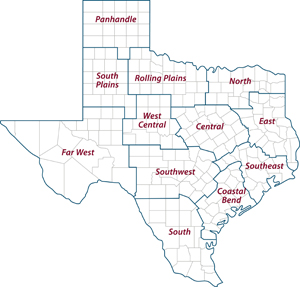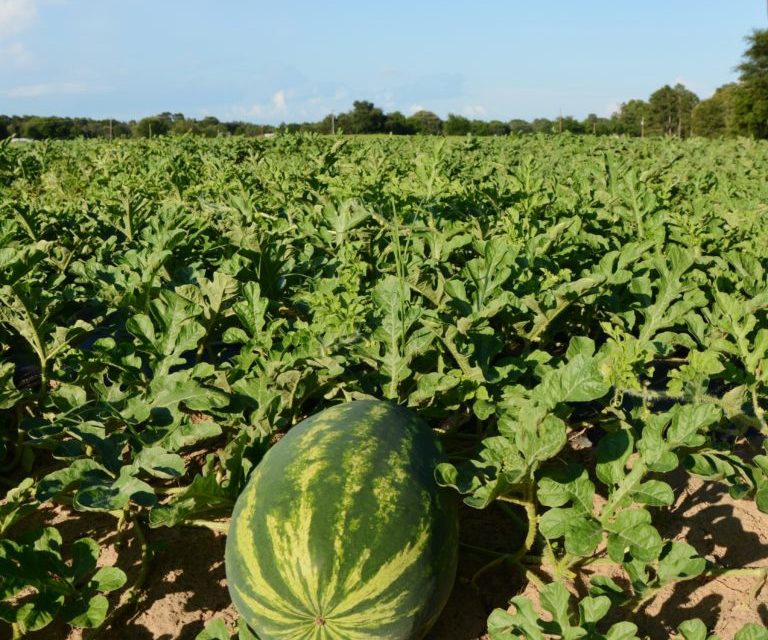by Adam Russell
The Texas watermelon crop was delayed by spring weather, but plenty should be available for the Fourth of July holiday, according to a Texas A&M AgriLife Extension Service expert.
Dr. Larry Stein, AgriLife Extension horticulturist, Uvalde, said the state’s melon crops were showing good fruit sets and are progressing well after a challenging spring.
Stein said melon producers avoided major disease and pest issues this season. However, cloudy weather has pushed their grow date later than usual. Some areas in which melons are typically ripening in time for the Fourth of July holiday weekend could miss that peak melon-sales period.
“They want to have them ready for market a week to 10 days before the holiday weekend,” he said. “The cloudy weather may delay the beginning of harvest for a lot of producers who usually aim for that window.”
Producers in the Rio Grande Valley have been harvesting early varieties for a few weeks and should have plenty of melons for July 4. Other melon-producing areas, including the Texas Wintergarden area, Central Texas and East Texas should follow.
Cloudy days may delay harvest, but recent sunshine should improve flavor, Stein said.
“The amount of rain really won’t affect the flavor,” he said. “It’s the sunshine that matters. Cloudy weather slows growth, but the leaves can’t manufacture the sugar for the melon, so taste could be a problem on some early varieties if they haven’t been getting the sun they need.”
Producers applied fungicides to avoid disease issues related to above-average soil moisture levels, but their management of wind could be an issue as the crops progress.
Stein said windbreaks are sometimes overlooked as a valuable part of melon production. Some producers plant winter wheat and leave rows of stubble for vines to cling to throughout the season as well as reduce the impact of winds.
Melon vines that are not provided windbreaks can become twisted together by winds, which can restrict vine growth and productivity, Stein said.
“It’s amazing what windbreaks can do to help vines to grow,” he said. “Providing protection from the wind is important from the start. You don’t really see how it affects the plants’ output, but we know it hinders development of the vines, especially for producers who use plastic and drip lines.”
Texas continues to rank No. 1 in the nation in watermelon production, Stein said.
Watermelons were an $87.5 million crop in 2018, according to an AgriLife Extension economic report. Other melons add more than $5 million to that crop value.
AgriLife Extension district reporters compiled the following summaries:

CENTRAL: Temperatures were cooler but returned to normal highs late in the reporting period, reaching the mid-to-upper 90s. Rains of 1-2 inches were reported in some areas while other areas missed additional moisture. Some low-lying areas were underwater. Hay balers were very active but were stalled again by rains. Producers reported four to five bales per acre. Weeds were a big issue for crop and vegetable growers due to rain. Pastures and rangelands were producing well. Crops were growing steadily, but maturity varied across the district. Soils were still too wet to plant cotton. Planted cotton was starting to grow well. Wheat harvest and other fieldwork resumed, and most producers have gotten wheat out of their fields. Corn and sorghum were not doing well because of excessive rainfall. Nearly all counties reported livestock were in good condition.
ROLLING PLAINS: The district received up to 5 inches of rain. Wet conditions prevented cotton planting in some fields, and some wheat harvest was delayed. Storms created more damage in unharvested fields. Some producers reported above-average yields, but test weights and protein levels were lower than normal due to prolonged rain. Pastures looked very good, and cattle were in good shape. Hay swathing and baling was slowed due to high humidity and rains.
COASTAL BEND: Beneficial rains fell with amounts ranging from 2-4 inches. Early planted cotton was starting to bloom, but much of the cotton crop was about three weeks behind schedule. Wharton County reported some cotton fields near the Tres Palacios River remained submerged as waters were slow to recede from flood levels in the previous reporting period. Wet weather conditions brought cotton fleahoppers, which reached threshold and required repeated applications of insecticide. Moist conditions also created ideal conditions for southern corn rust. Some fungicide applications were made in the upper portion of the reporting area. Corn and grain sorghum continued to look exceptional and should have adequate moisture to finish out. Weeds were still an issue in some fields. Hay harvest continued. Bales were in abundance and selling for below-average prices. Some ranchers were shredding weeds due to lack of favorable spray conditions in early spring. Livestock were doing well.
EAST: The abundance of rainfall caused water damage to corn crops and prevented the planting of cotton in Anderson County. Hay producers baled large quantities of quality hay. Pasture and rangeland conditions were good. Subsoil and topsoil conditions were adequate. Temperatures were cooler than the previous reporting period. Livestock were in good condition. Houston County continued to report problems with the fly populations. Wild pigs were very active in Henderson and Anderson counties.
SOUTH PLAINS: Temperatures were warmer, and pockets of rainfall were reported. Subsoil and topsoil moisture remained short to adequate as some area counties received more rainfall than others. Cotton was growing with good heat unit accumulation. Producers were active in the field. Cotton planting continued with some being replanted due to rain. Some cotton was emerging, but most was behind schedule due to all the rain. Producers tried to control windblown dirt as the crop emerged. Sorghum was being planted where weather prevented cotton planting. Pasture, rangeland and winter wheat remained in fair condition. Producers continued to plant. Cattle were in good condition.
PANHANDLE: Producers played catch-up following recent weather events. A few cotton producers finished replants. Most cotton and peanut fields were switched to other crops such as sorghum or corn because of time limitations. Planting into moisture caused fungus on cotton leaves and could not be salvaged. Cattle and pasture conditions looked great with the abundant rainfall.
NORTH: Soil moisture was adequate to surplus across the district. Storms brought half an inch to 4 inches of precipitation. Before the rains, soils had dried enough for producers to harvest wheat. Farmers reported good yields, 30-50 bushels per acre. Croplands were still too wet to access in some places. Late-planted corn was responding well to the extra moisture. Most pastures were in good shape. Hay producers were able to get in most pastures. Ponds were full. Creeks, ditches and some streets were full or overflowing. Saturation was causing concern in some areas. Cattle were in good condition.
FAR WEST: Temperatures ranged from highs in the upper 90s to lows in the mid-50s. Scattered showers were reported throughout the district. Rain averages were around half an inch to 2 inches. Producers made progress harvesting wheat with high yields reported. Cotton was starting to mature and not far from squaring as temperatures warmed. The main threat to emerged cotton was sandblasting by high winds. Many producers were sandfighting and trying to hold the soil in place. Some producers were forced to replant fields due to inclement weather. Sorghum was starting to head out. Corn was expected to begin tasseling soon. Pastures were starting to dry, and there was a limited amount of grass. Livestock conditions remained good. Jumbo grasshoppers were reported and controlled in the eastern part of the district.
WEST CENTRAL: The district had a relatively dry week. Cotton producers were able to resume planting. Winter wheat harvest resumed and mostly completed. Some producers harvested their first cutting of hay. Sorghum fields were in excellent condition. Rangeland continued to look good with good grazing for cattle. Most ponds were full and running over. The cattle market opened with an aggressive tone on most calves and yearlings. Stocker steers and heifers sold steady to $5 higher per hundredweight. Prices on feeder steers and heifers were steady to up to $3 higher per hundredweight. Packer bulls sold $2 higher, and cows sold $1 higher. Replacement cattle sold steady.
SOUTHEAST: Some areas received rain while other areas stayed dry. A lot of hay was cut, and conditions were starting to dry. Pastures were too saturated to access in some areas. A smaller percentage of producers were harvesting their second cuttings. Vegetable gardens were doing well. Tomato producers were monitoring moisture levels to prevent blossom-end rot. In Jefferson County, the rain prevented rice from being planted before the final planting date. The rains also put forage production into overdrive. Rangeland and pasture ratings were excellent to poor with good being most common. Soil moisture levels were adequate to surplus with adequate being most common.
SOUTHWEST: Most counties received more rain, from trace amounts up to 7 inches. Rangeland and pastures continued to thrive. Thistles were particularly abundant. Most wheat was harvested. Cotton continued to look good, and corn was maturing nicely. Livestock and wildlife were in good condition. Rivers, creeks and streams were flowing.
SOUTH: Northern and southern parts of the district reported hot weather and short soil moisture levels. Eastern parts of the district reported hot and dry weather conditions with adequate soil moisture levels. Western parts of the district reported warm weather conditions with rainfall and adequate to short soil moisture levels. Maverick County reported beneficial rains of half an inch to 1 inch in some areas. Some producers in Zapata County reported up to 4.5 inches of rainfall. Starr County reported scattered rains with amounts ranging from traces up to 5 inches. Potato and sweet corn continued to be harvested. Bermuda grass cutting and baling started. Corn fields continued to turn color and were maturing. Cotton fields received beneficial heat units and were entering the first bloom stage under irrigation. Native rangelands and pastures were mostly good due to adequate rainfall, but some areas reported declining conditions due to heat and little rain. Cattle body condition scores were fair to excellent. Coastal Bermuda grass fields were in good condition and producing good hay bales. Pecan orchards were also in good condition with no reports of pest issues. Watermelons and cantaloupes were being harvested on schedule. Cotton, sorghum, corn and cucumbers were under irrigation due to dry, hot conditions. Producers in Dimmit County were still providing supplemental feed and hauling water for livestock.





